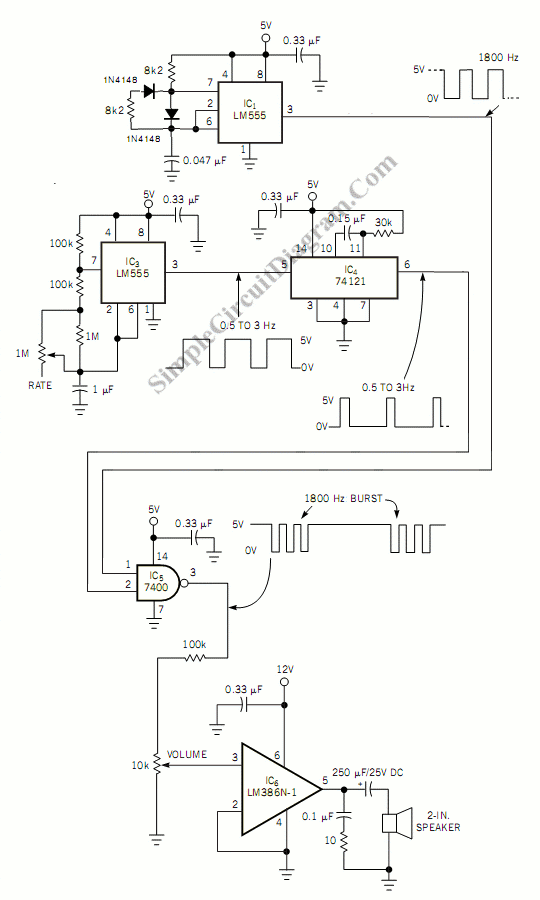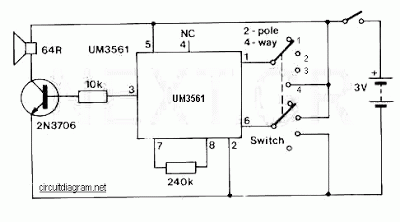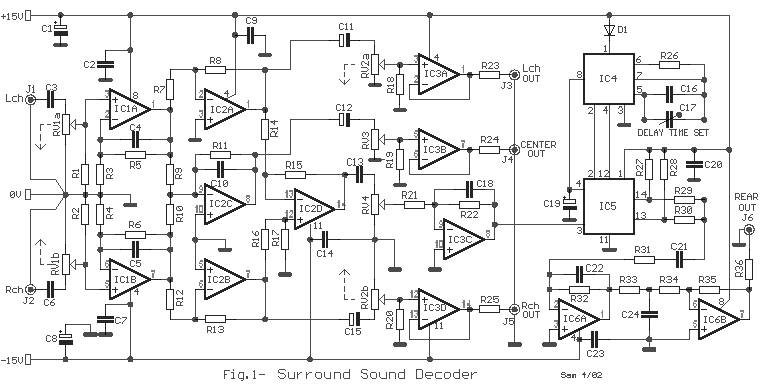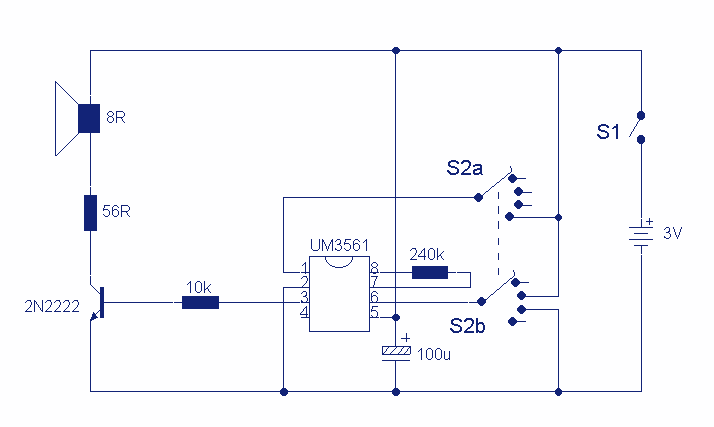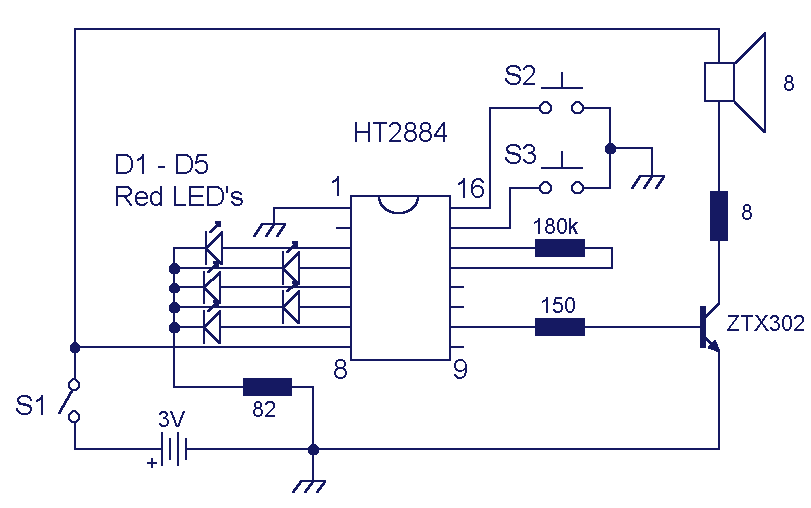
Cuckoo sound Generators
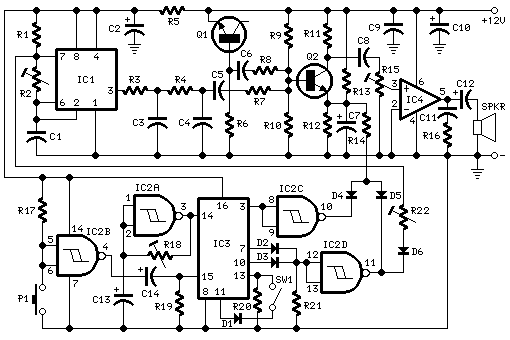
This circuit generates a two-tone effect similar to the sound of a cuckoo. It can be utilized for doorbells or other applications due to its integrated audio amplifier and loudspeaker. When used as a sound effect generator, it can be connected to external amplifiers, tape recorders, etc. In this scenario, the built-in audio amplifier and loudspeaker may be omitted, with the output taken from capacitor C8 and ground. There are two operational modes: free-running, when switch SW1 is left open, and one-shot, when SW1 is closed. In the one-shot mode, a two-tone cuckoo sound will be generated each time pushbutton P1 is pressed. Integrated circuit IC1 is configured as a square wave generator, producing both tones of the cuckoo sound. The frequency of the higher tone (667 Hz) is adjusted using trimmer resistor R2. When the output of IC2D goes low, an additional trimmer (R22) is connected to the timing components of IC1 via diode D6, generating the lower tone (545 Hz). To closely replicate the cuckoo sound, the square wave output of IC1 is transformed into a quasi-sinusoidal waveform by resistors R3, R4, and capacitors C3, C4, and is mixed with white noise generated by transistor Q1 and resistor R6. Transistor Q2 serves two functions: it mixes the two incoming signals and gates the resulting tone, shaping its attack and decay characteristics through the components connected to its emitter. The various sound and pause timings are managed by clock generator IC2A, which drives decade counter IC3. Certain output pins of this IC are gated by IC2C, IC2D, and associated components to control the sound generator and gate. In free-running mode, with SW1 open, the circuit continuously produces a cuckoo sound. When SW1 is closed, the circuit generates the two tones and then stops, as a high state appears at the last output pin (#11) of the decade counter IC, inhibiting the count through diode D1 feeding into pin #13. Optimal results are achieved when the frequencies of the two tones are accurately set, specifically 667 Hz for the first tone and 545 Hz for the second, which corresponds to a minor third interval in musical terms. A digital frequency counter is the ideal tool for calibrating R2 and R22, though a musical instrument such as a piano or guitar can also be utilized for tuning by ear.
The circuit design employs a combination of integrated circuits, discrete components, and transistors to achieve the desired audio effect. The use of IC1 as a square wave generator allows for precise control over the frequency of the generated tones, while the trimmer resistors enable fine-tuning to achieve the correct pitches. The transformation of the square wave to a quasi-sinusoidal waveform is crucial for mimicking the natural sound of a cuckoo, as it provides a smoother audio output that is more pleasing to the ear.
The inclusion of a noise generator (Q1 and R6) adds richness to the sound, making it more realistic. The gating function of Q2 is essential for controlling the dynamics of the sound, allowing for a more expressive output that can simulate the nuances of the cuckoo call. The timing of the sound and pauses is managed through a clock signal from IC2A, which ensures that the two-tone sequence is well-coordinated and rhythmic.
In practical applications, the circuit can be adapted for various uses beyond doorbells, such as in toys, alarms, or sound effects in multimedia projects. The flexibility of connecting to external amplifiers or recording devices further enhances its usability. Overall, this circuit exemplifies a creative approach to sound synthesis, leveraging basic electronic components to produce a recognizable and engaging auditory effect.This circuit generates a two-tone effect very much alike the cuckoo sound. It can be used for door-bells or other purposes thanks to a built-in audio amplifier and loudspeaker Used as a sound effect generator it can be connected to external amplifiers, tape recorders etc. In this case, the built-in audio amplifier and loudspeaker may be omitted an d the output taken from C8 and ground. There are two options: free running, when SW1 is left open, and one-shot, when SW1 is closed. In this case a two-tone cuckoo sound will be generated each time P1 pushbutton is pressed. IC1 is wired as a squarewave generator and produces both tones of the cuckoo sound. The frequency of the higher one (667Hz) is set by means of Trimmer R2. When IC2D output goes low, a further Trimmer (R22) is added to IC1 timing components via D6, and the lower tone (545Hz) is generated. To imitate closely the cuckoo sound, the squarewave output of IC1 is converted to a quasi-sinusoidal waveform by R3, R4, C3 and C4, then mixed with the white noise generated by Q1, R6.
Q2 has two purposes: it mixes the two incoming signals and gates the resulting tone, shaping its attack and decay behavior by means of the parts wired around its Emitter. The various sound and pause timings for the circuit are provided by the clock generator IC2A driving the decade counter IC3.
Some output pins of this IC are gated by IC2C, IC2D and related components to drive appropriately the sound generator and the sound gate. When SW1 is left open the circuit operates in the free-running mode and a cuckoo sound is generated continuously.
When SW1 is closed, the circuit generates two tones then stops, because a high state appears at the last output pin (#11) of the decade counter IC: therefore the count is inhibited by means of D1 feeding pin #13. Best results will be obtained if the two tones frequencies are set precisely, i. e. 667Hz for the first tone and 545Hz for the second: in musical terms this interval is called a Minor Third.
Obviously a digital frequency counter, if available, would be the best tool to setup R2 and R22, but you can use a musical instrument, e. g. a piano or guitar, tuning-up the notes accurately by ear. 🔗 External reference
The circuit design employs a combination of integrated circuits, discrete components, and transistors to achieve the desired audio effect. The use of IC1 as a square wave generator allows for precise control over the frequency of the generated tones, while the trimmer resistors enable fine-tuning to achieve the correct pitches. The transformation of the square wave to a quasi-sinusoidal waveform is crucial for mimicking the natural sound of a cuckoo, as it provides a smoother audio output that is more pleasing to the ear.
The inclusion of a noise generator (Q1 and R6) adds richness to the sound, making it more realistic. The gating function of Q2 is essential for controlling the dynamics of the sound, allowing for a more expressive output that can simulate the nuances of the cuckoo call. The timing of the sound and pauses is managed through a clock signal from IC2A, which ensures that the two-tone sequence is well-coordinated and rhythmic.
In practical applications, the circuit can be adapted for various uses beyond doorbells, such as in toys, alarms, or sound effects in multimedia projects. The flexibility of connecting to external amplifiers or recording devices further enhances its usability. Overall, this circuit exemplifies a creative approach to sound synthesis, leveraging basic electronic components to produce a recognizable and engaging auditory effect.This circuit generates a two-tone effect very much alike the cuckoo sound. It can be used for door-bells or other purposes thanks to a built-in audio amplifier and loudspeaker Used as a sound effect generator it can be connected to external amplifiers, tape recorders etc. In this case, the built-in audio amplifier and loudspeaker may be omitted an d the output taken from C8 and ground. There are two options: free running, when SW1 is left open, and one-shot, when SW1 is closed. In this case a two-tone cuckoo sound will be generated each time P1 pushbutton is pressed. IC1 is wired as a squarewave generator and produces both tones of the cuckoo sound. The frequency of the higher one (667Hz) is set by means of Trimmer R2. When IC2D output goes low, a further Trimmer (R22) is added to IC1 timing components via D6, and the lower tone (545Hz) is generated. To imitate closely the cuckoo sound, the squarewave output of IC1 is converted to a quasi-sinusoidal waveform by R3, R4, C3 and C4, then mixed with the white noise generated by Q1, R6.
Q2 has two purposes: it mixes the two incoming signals and gates the resulting tone, shaping its attack and decay behavior by means of the parts wired around its Emitter. The various sound and pause timings for the circuit are provided by the clock generator IC2A driving the decade counter IC3.
Some output pins of this IC are gated by IC2C, IC2D and related components to drive appropriately the sound generator and the sound gate. When SW1 is left open the circuit operates in the free-running mode and a cuckoo sound is generated continuously.
When SW1 is closed, the circuit generates two tones then stops, because a high state appears at the last output pin (#11) of the decade counter IC: therefore the count is inhibited by means of D1 feeding pin #13. Best results will be obtained if the two tones frequencies are set precisely, i. e. 667Hz for the first tone and 545Hz for the second: in musical terms this interval is called a Minor Third.
Obviously a digital frequency counter, if available, would be the best tool to setup R2 and R22, but you can use a musical instrument, e. g. a piano or guitar, tuning-up the notes accurately by ear. 🔗 External reference
